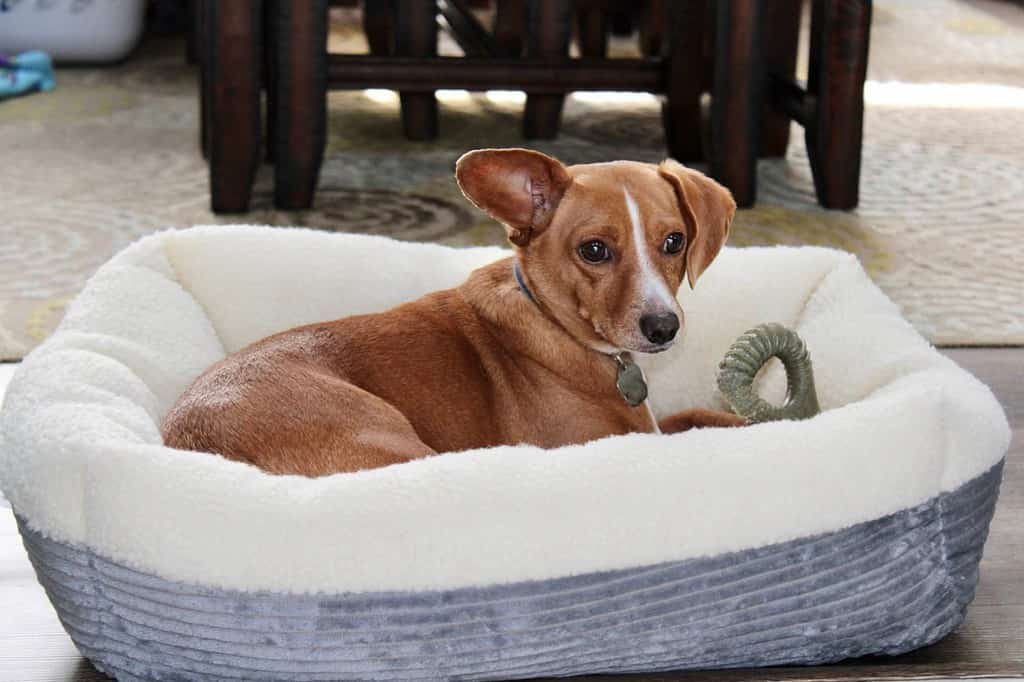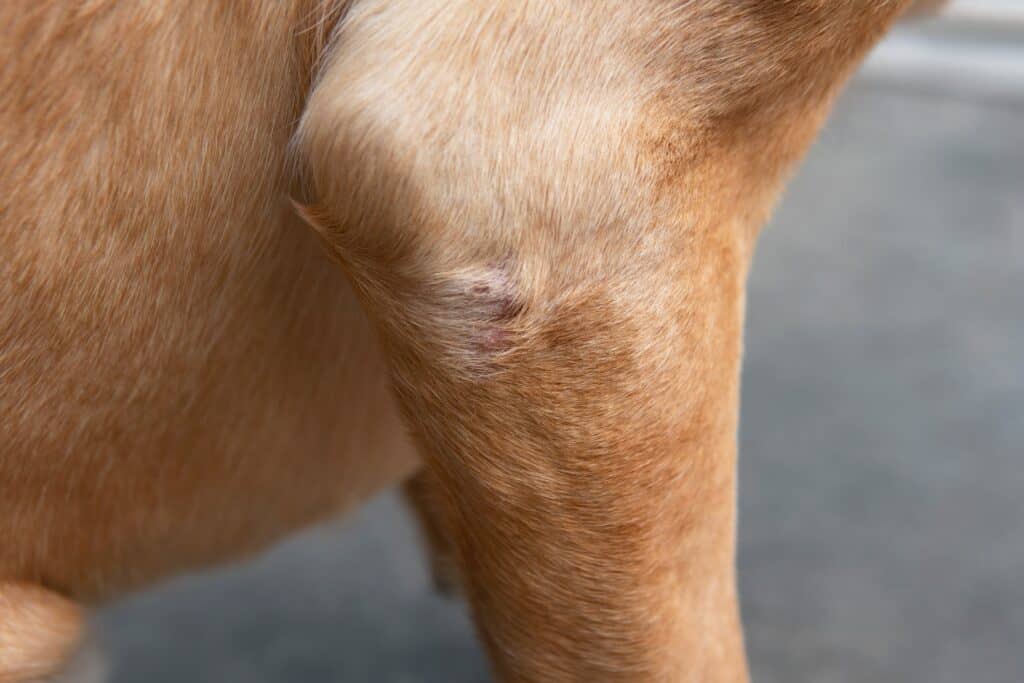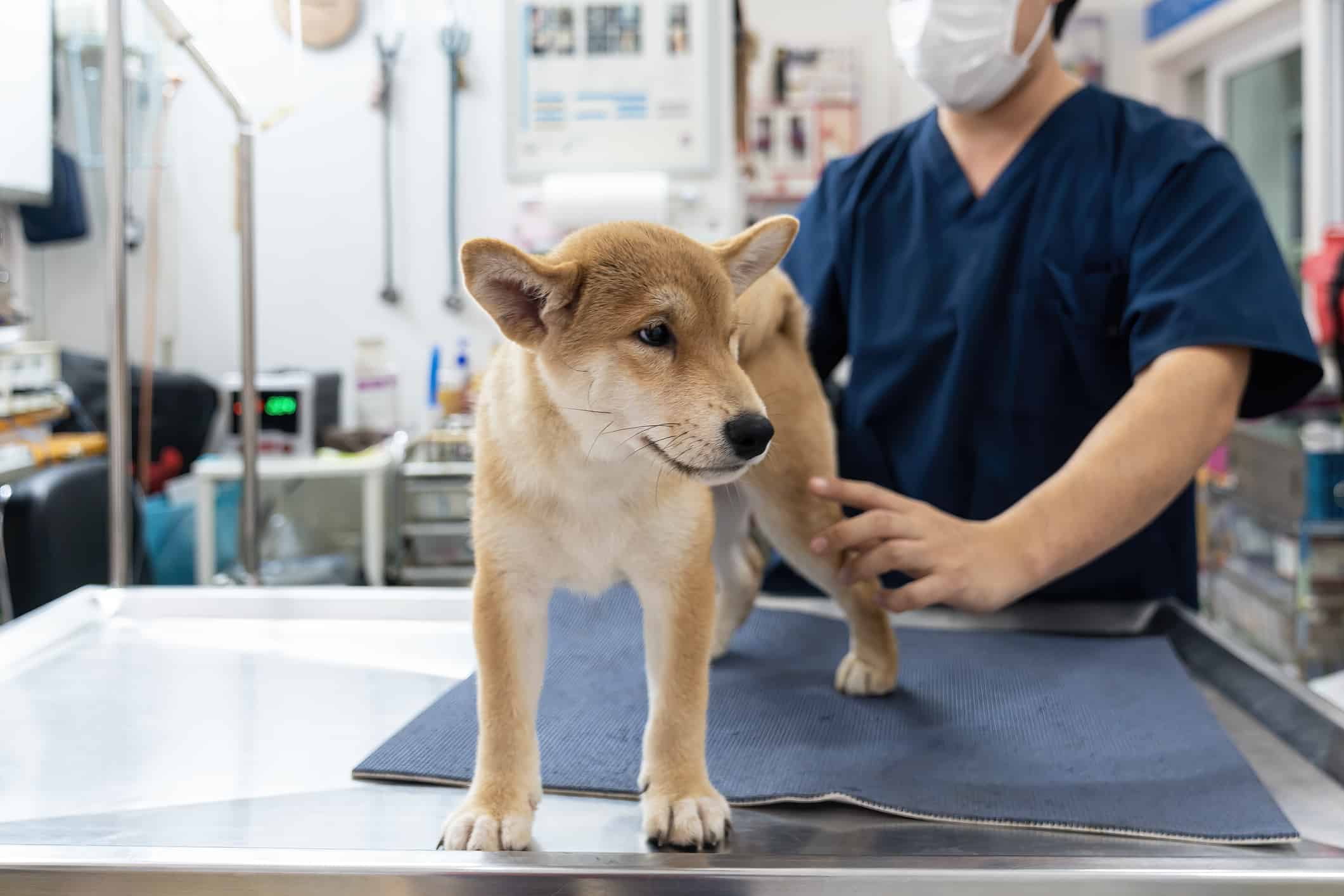Elbow dysplasia refers to several growth problems with the elbow joint. For one reason or another, the puppy’s elbow doesn’t grow properly, leading to excessive wear and other side effects. Eventually, the dog will start showing signs of elbow dysplasia, usually by age four.
In most cases, both elbows are affected. Therefore, your dog will show signs of elbow dysplasia on both sides. However, in about 20% of cases, the dog will only show signs of elbow dysplasia on one side.
This disease is progressive, meaning it gets worse as time goes by. It’s important to catch and treat it early to slow progression as much as possible. Below, we’ll look at the most common signs of elbow dysplasia in dogs so that you can pick up on the warning signs.
1. Lameness or Limping

Dogs with elbow dysplasia tend to spend more of their time in bed.
©Jaclyn Vernace/Shutterstock.com
Elbow dysplasia causes the elbow joint to hurt, similar to arthritis. Therefore, a dog with elbow dysplasia will limp or become lame. The pain may increase after activity and exercise. Sometimes, the dog may walk fine in the morning before they become active, only to become obviously pained as the day continues.
You’d imagine that limping would be pretty easy to notice. However, both elbows are usually affected, meaning the dog will limp on both sides. Their gait may stay pretty even, making picking up on the limping harder.
Still, this sign of elbow dysplasia is often the first pet parents notice.
Dogs with more extreme elbow dysplasia may become unwilling to exercise. Some dogs refuse to walk or get up altogether. Lameness can occur slowly as the disease progresses or appear suddenly.
2. Stiffness
Elbow dysplasia can make the elbow joint not work as well for some dogs. It may not bend or extend properly, leading to a lower range of movement. The dog’s gait will shift appropriately. They may have to swing their leg out more.
Many people describe their dog’s gait as “robotic.” They may not walk with the same flow as they once did. Often, this sign is most obvious when the dog is running.
A shift in gait can start affecting other joints, as well. Therefore, seeking treatment at your vet is important if your dog starts walking strangely.
3. Swollen and Puffy Elbows

Checking for swelling can be challenging if you don’t know what your dog’s elbow typically looks like.
©9gifts/Shutterstock.com
Damaged elbows often become swollen, especially after exercise. Your dog’s joint may be obviously inflamed and puffy. They may also yelp when you touch the joint or attempt to make you stop touching it. Some dogs even become aggressive, which is often a sign of pain.
If both elbows are affected, picking up on slight puffiness can be harder. You may not notice a difference if both sides are swollen about the same. However, when only one side is affected, you’ll have an unswollen joint to compare it to, making the difference more obvious.
Either way, this sign is often not the first one owners notice.
4. Reluctance to Exercise
Some dogs make their pain very clear. They may refuse to get out of bed, yelp when you touch their elbow, and limp dramatically. Other dogs may not be as dramatic. In fact, many dogs don’t show any signs of pain until the disease progresses. There may be no obvious limping or swelling.
One of the earliest signs of elbow dysplasia is a reluctance to exercise. Even if a dog’s elbows hurt very little, they may not want to move around and make the pain worse. They may not feel pain when lying still, so that’s exactly what many of them do.
If your dog goes from loving walks to laying in bed and hoping you forget about their existence, something is probably wrong. Picking up on this early sign and seeking vet attention (even if your dog has no other symptoms) can make treatment more effective.
5. “Bunny Hopping”

Large dogs like
Cane Corsos
are often most prone to elbow dysplasia, but it can technically occur in any dog breed.
©Sbolotova/Shutterstock.com
When a dog’s elbows hurt, they may try to walk with their elbows turned outwards. This gait prevents their elbows from bending as much, which can prevent pain. However, it does make your dog’s gait obviously wrong. Many dog owners describe it as “hopping” like a bunny.
Your dog probably won’t do this constantly. However, if their elbows start hurting, they may shift to this gait. Walking in this manner is often a sign that something is off and should send you to the vet.
That said, any elbow pain can cause this strange gait. Therefore, any condition that affects the elbow joint can lead to bunny hopping. Your vet can determine if it’s elbow dysplasia or something else.
6. Head Bobbing
Some dogs take to bobbing their head whenever they walk, as this may lower the amount of pain in their elbow joint. Not all dogs shift their gait in this way. Some may decide to “bunny hop” instead. Because head bobbing is less obvious, the dog’s owners may not notice it as quickly.
Furthermore, dogs won’t always bob their head when they walk. They may only do it occasionally.
Ready to discover the top 10 cutest dog breeds in the entire world?
How about the fastest dogs, the largest dogs and those that are -- quite frankly -- just the kindest dogs on the planet? Each day, AZ Animals sends out lists just like this to our thousands of email subscribers. And the best part? It's FREE. Join today by entering your email below.
Thank you for reading! Have some feedback for us? Contact the AZ Animals editorial team.








